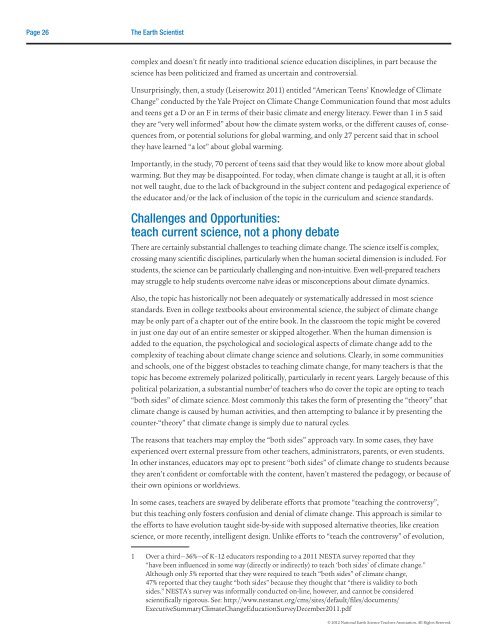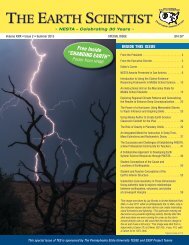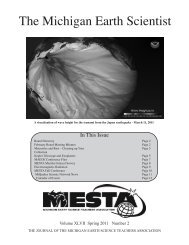The Earth Scientist
Fall 12.pdf - NESTA
Fall 12.pdf - NESTA
- No tags were found...
Create successful ePaper yourself
Turn your PDF publications into a flip-book with our unique Google optimized e-Paper software.
Page 26<br />
<strong>The</strong> <strong>Earth</strong> <strong>Scientist</strong><br />
complex and doesn’t fit neatly into traditional science education disciplines, in part because the<br />
science has been politicized and framed as uncertain and controversial.<br />
Unsurprisingly, then, a study (Leiserowitz 2011) entitled “American Teens’ Knowledge of Climate<br />
Change” conducted by the Yale Project on Climate Change Communication found that most adults<br />
and teens get a D or an F in terms of their basic climate and energy literacy. Fewer than 1 in 5 said<br />
they are “very well informed” about how the climate system works, or the different causes of, consequences<br />
from, or potential solutions for global warming, and only 27 percent said that in school<br />
they have learned “a lot” about global warming.<br />
Importantly, in the study, 70 percent of teens said that they would like to know more about global<br />
warming. But they may be disappointed. For today, when climate change is taught at all, it is often<br />
not well taught, due to the lack of background in the subject content and pedagogical experience of<br />
the educator and/or the lack of inclusion of the topic in the curriculum and science standards.<br />
Challenges and Opportunities:<br />
teach current science, not a phony debate<br />
<strong>The</strong>re are certainly substantial challenges to teaching climate change. <strong>The</strong> science itself is complex,<br />
crossing many scientific disciplines, particularly when the human societal dimension is included. For<br />
students, the science can be particularly challenging and non-intuitive. Even well-prepared teachers<br />
may struggle to help students overcome naïve ideas or misconceptions about climate dynamics.<br />
Also, the topic has historically not been adequately or systematically addressed in most science<br />
standards. Even in college textbooks about environmental science, the subject of climate change<br />
may be only part of a chapter out of the entire book. In the classroom the topic might be covered<br />
in just one day out of an entire semester or skipped altogether. When the human dimension is<br />
added to the equation, the psychological and sociological aspects of climate change add to the<br />
complexity of teaching about climate change science and solutions. Clearly, in some communities<br />
and schools, one of the biggest obstacles to teaching climate change, for many teachers is that the<br />
topic has become extremely polarized politically, particularly in recent years. Largely because of this<br />
political polarization, a substantial number 1 of teachers who do cover the topic are opting to teach<br />
“both sides” of climate science. Most commonly this takes the form of presenting the “theory” that<br />
climate change is caused by human activities, and then attempting to balance it by presenting the<br />
counter-“theory” that climate change is simply due to natural cycles.<br />
<strong>The</strong> reasons that teachers may employ the “both sides” approach vary. In some cases, they have<br />
experienced overt external pressure from other teachers, administrators, parents, or even students.<br />
In other instances, educators may opt to present “both sides” of climate change to students because<br />
they aren’t confident or comfortable with the content, haven’t mastered the pedagogy, or because of<br />
their own opinions or worldviews.<br />
In some cases, teachers are swayed by deliberate efforts that promote “teaching the controversy”,<br />
but this teaching only fosters confusion and denial of climate change. This approach is similar to<br />
the efforts to have evolution taught side-by-side with supposed alternative theories, like creation<br />
science, or more recently, intelligent design. Unlike efforts to “teach the controversy” of evolution,<br />
1 Over a third—36%—of K–12 educators responding to a 2011 NESTA survey reported that they<br />
“have been influenced in some way (directly or indirectly) to teach ‘both sides’ of climate change.”<br />
Although only 5% reported that they were required to teach “both sides” of climate change,<br />
47% reported that they taught “both sides” because they thought that “there is validity to both<br />
sides.” NESTA’s survey was informally conducted on-line, however, and cannot be considered<br />
scientifically rigorous. See: http://www.nestanet.org/cms/sites/default/files/documents/<br />
ExecutiveSummaryClimateChangeEducationSurveyDecember2011.pdf<br />
© 2012 National <strong>Earth</strong> Science Teachers Association. All Rights Reserved.






